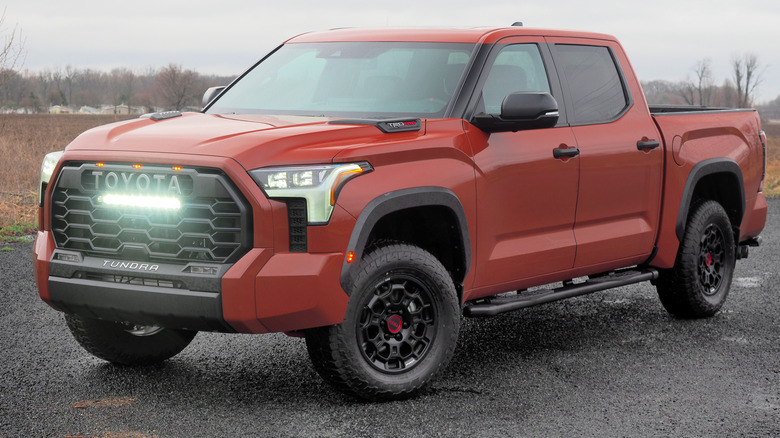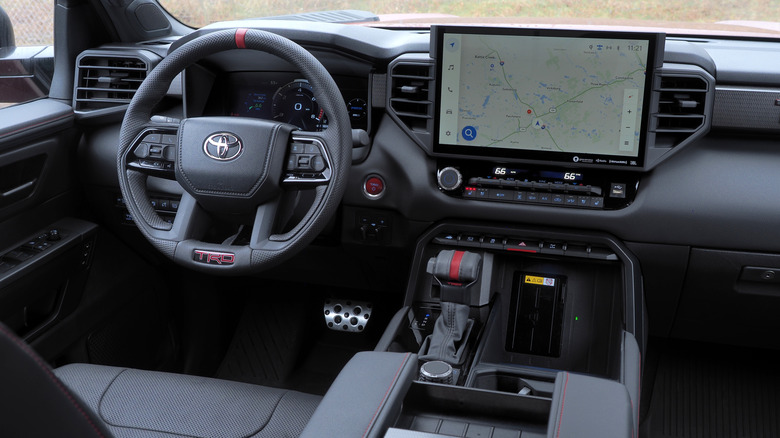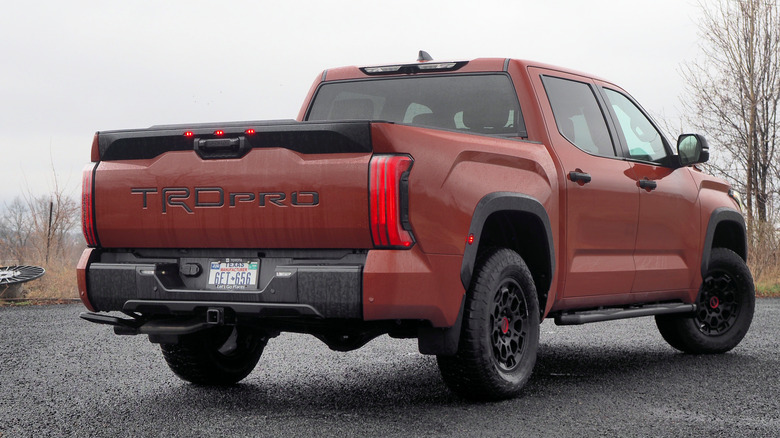
Chris Davies/SlashGear
Anyone who thinks full-size gas pickups have been immune to new technology and tightening economy demands might not have seen the inroads electrification has made to the segment. Though — as the 2024 Toyota Tundra i-FORCE MAX demonstrates well — just how automakers deliver on hybrids can vary. Toyota is no stranger to the gas-electric combo, having popularized the concept with its Prius, though its beefy truck has different priorities which those chasing miles-per-gallon (mpg) gains above all else should bear in mind.
The Tundra’s hybrid drivetrain takes a familiar approach, though different from what’s found in the latest Prius platform. Toyota slots its single electric motor in-between the twin-turbo V6 gas engine and the 10-speed automatic transmission. Known as a parallel hybrid system, it means the electric motor can contribute to the power output from the gas engine, or — spinning in reverse — be used as a generator to top up the battery.
That battery is a lot smaller in capacity than what you’d expect to find in a full-EV. The nickel-metal hydride (Ni-MH) pack has a mere 1.87 kWh capacity — a Toyota bZ4X, in contrast, has a 71.4 kWh battery — which Toyota hides under the rear bench, where the non-hybrid Tundra offers a storage compartment. The battery can be small because it’s not really intended to move the Tundra on electric power alone.
Designed to replace a V8

Chris Davies/SlashGear
In fact, while they might both be hybrid-electric, the Prius and the Tundra each have very different focuses for their drivetrains. For the Prius, electrification is a way to save gas and boost fuel economy: it’s rated at up to 57 mpg combined by the U.S. EPA, more than double what the average new 2024 vehicle is expected to achieve. To hit that, we found in our Prius review, it switches to electric-only power as much as possible, minimizing how much gas it has to burn.
With the Tundra, though, Toyota is pitching a V6 engine to a segment that would commonly expect a V8. That’s not always the case anymore — thanks to efforts to increase the performance of turbocharged gas engines — but generally the demands of full-size truck owners are centered around horsepower, torque, and tow capacity. You’re not meant to drive the Tundra hybrid as an electric-only vehicle (in fact, there’s not even an ‘EV Mode’ button like the Prius offers, though at times of very low drivetrain demand the truck might decide to use EV power alone), but to reap the combined benefits of gas and electric together.
The electric motor may only contribute 48 horsepower and 184 lb-ft of torque, but as we’ve seen in fully electric vehicles, that torque arrives straight away. In the Tundra, it fills in the gap as the gas engine spins up its turbos and achieves its own maximum output. The result is 437 horsepower and 583 lb-ft of torque, more than competitive against a V8 truck.
Is frugal and fast too much to ask?

Chris Davies/SlashGear
Hybrids aren’t magic, though, and despite their potential for frugality, that doesn’t mean electrification is automatically greener. The Tundra i-FORCE MAX doesn’t just meet its gas-only rivals on grunt, but on thirst. The EPA says you could see 18 mpg in the city, 20 mpg on the highway, and 19 mpg combined from the TRD Pro. That’s slightly worse than the same engine in the Tundra Capstone, in fact, a penalty that comes down in no small part to the TRD Pro’s off-road-ready tires.
Regardless of wheels, Toyota’s truck isn’t moving the needle from where full-size V8 trucks typically land. A V8 Ford F-150, for example, matches the Tundra hybrid’s combined figure (though does better on the highway, and worse in the city); the same goes for Ram’s V8 in the 1500. Chevrolet’s V8 in the Silverado is thirstier in both 5.3-liter and 6.2-liter forms. And, in our own testing of the hybrid Tundra TRD Pro, mixed driving saw it hit a combined 14.5 mpg at best.
That economy versus power balance is an automaker decision, mind. Ford’s more powerful and redesigned 2024 F-150 hybrid — combining electrification with a 3.5-liter turbocharged V6 — clocks in at 23 mpg combined and bests the Tundra hybrid both on the highway and in the city. That’s despite only being down 7 horsepower and 13 lb-ft of torque in comparison to the Toyota. There’s no denying that the Tundra is a surprisingly spritely truck to drive, despite the curb weight, but Toyota’s drivetrain makes a clear decision in favor of performance. It’s one you’ll be reminded of every time you pull up at a gas pump.